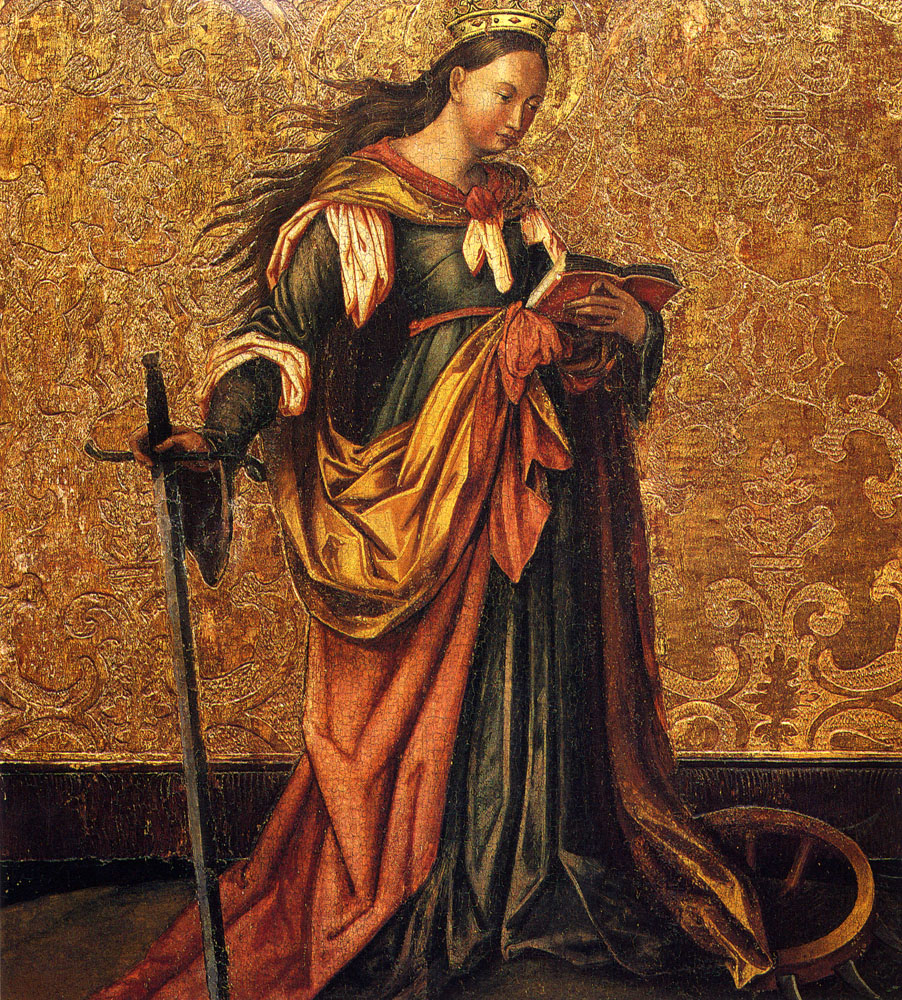November 25: Feast Day for St Catherine of Alexandria
‘The Holiness of Broken Things’
– for Charles Schweigert and St. Catherine
the base is the ark
where Noah cradled all creatures
the base is the barque
where Christ slept through the storm
anchoring a broken orb
of once rusty scrap metal
transformed by faith in beauty
the martyr’s wheel rises
the break beatified
by a fragrant halo
silvery traces of the soul’s flight
toward paradise
leaving behind
for our solace
a delicate blue flower
love-in-a-mist
Sculpture by Charles Sweigert. Poem by Karin Temple
SAINT CATHERINE
OF ALEXANDRIA
VIRGIN and MARTYR C. 310 A.D.
There is no denying that Catherine of Alexandria is an obscure saint, and an also an uncommon name for an Episcopal church. (I guess I must have some strange connection to obscure saints – the first church I served was St. Wilfrid of York in Huntington Beach, CA. Ever heard of him? Well, neither had I.)
In any case, this week we celebrate the Feast Day of St. Catherine of Alexandria, so it seems appropriate to dedicate this issue of the Tidings to what we know about her.
The veneration of “Catherine of Alexandria” has its historical origins in the persecutions of Christians that took place in the Roman Empire right at the beginning of the fourth century. There is really no hard evidence of Catherine herself being a “real” historical figure – rather, it is thought she may have been a composite drawn from memories of women who were persecuted by their faith.
That said, Catherine’s story is an inspiring one – a story of a woman remembered for her intelligence, her wisdom, her tenacity, and her faith. According to tradition, she was born of a patrician family of Alexandria and from childhood devoted herself to study. She learned about Christianity through her reading, and converted after receiving a vision of Our Lady and the Holy Child.
remembered for her intelligence, her wisdom, her tenacity, and her faith. According to tradition, she was born of a patrician family of Alexandria and from childhood devoted herself to study. She learned about Christianity through her reading, and converted after receiving a vision of Our Lady and the Holy Child.
When the Roman Emperor Maxentius began his persecution, Catherine went to him and rebuked him boldly for his cruelty. It is said he couldn’t answer her arguments against his pagan gods, and that he then summoned fifty philosophers to confute her. They all confessed themselves won over by her reasoning, and were thereupon burned to death by the enraged Emperor! Then, even after she was beaten and imprisoned, she continued her efforts, managing to convert the Emperor’s wife, Faustina, a high official named Porphyrius, and many of the soldiers of the guard. They too were put to death, and Catherine was sentenced to be killed on a spiked wheel.
When she was fastened to the wheel, her bonds were miraculously loosed and the wheel itself broke, its spikes flying off and killing some of the onlookers. She was then beheaded.
 Eventually, St. Catherine became known as the patroness of young women, philosophers, preachers, theologians, wheelwrights, millers, and other workingmen. She was said to have appeared with Our Lady to St. Dominic and to Blessed Reginald of Orleans, and was adopted her as their special protectress by the Dominican order. It is also said that hers was one of the heavenly voices heard by another unusual woman saint, Joan of Arc. In iconography, Catherine is often portrayed wearing a crown, or next to the wheel that represents how she was tortured; other emblems are a lamb and a sword.
Eventually, St. Catherine became known as the patroness of young women, philosophers, preachers, theologians, wheelwrights, millers, and other workingmen. She was said to have appeared with Our Lady to St. Dominic and to Blessed Reginald of Orleans, and was adopted her as their special protectress by the Dominican order. It is also said that hers was one of the heavenly voices heard by another unusual woman saint, Joan of Arc. In iconography, Catherine is often portrayed wearing a crown, or next to the wheel that represents how she was tortured; other emblems are a lamb and a sword.
So, after learning her story, I find myself glad to serve a church dedicated to her memory. The Christian world needs women saints like her, reminding us today that, even from times of antiquity, there are stories that remember and honor the lives and witness of women who are wise, brave, and faithful.
The Rev. Patricia Steagall is the Vicar at St. Catherine of Alexandria Episcopal Church and the Associate for Spanish Language Ministry at Kaleidoscope Institute.
Image: Konrad Witz
First published here


